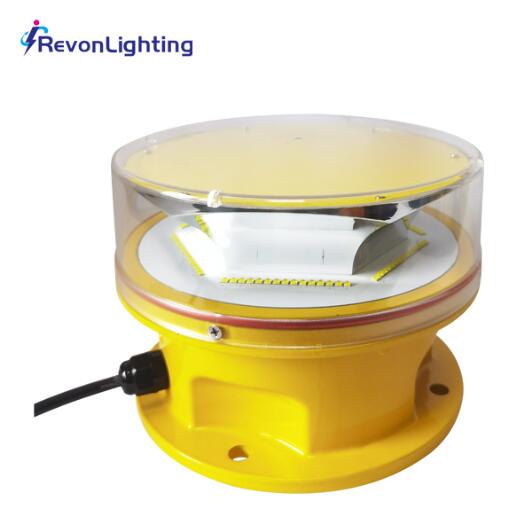Posted: 2024-07-13
In aviation, ensuring the visibility of tall structures is critical for maintaining safety. Pilots must be able to identify and avoid obstacles to prevent collisions and ensure safe flight paths. Two key components in this safety infrastructure are the L 810 LED obstruction light and the broader obstruction lighting system. This article explores the importance, features, and applications of these lighting solutions, emphasizing their role in enhancing aviation safety.
The Role of L 810 LED Obstruction Light
The L 810 LED obstruction light is a low-intensity lighting fixture specifically designed to mark obstacles that could pose hazards to aircraft. These lights are typically red and provide a steady illumination, making them easily recognizable to pilots, especially during nighttime or in low-visibility conditions.

Features of L 810 LED Obstruction Light
Energy Efficiency: Utilizing LED technology, the L 810 LED obstruction light is highly energy-efficient, consuming less power while providing bright illumination. This results in lower operating costs and a reduced environmental impact.
Long Lifespan: LEDs have a significantly longer lifespan compared to traditional incandescent or halogen bulbs, reducing the frequency of replacements and maintenance.
Durability: These lights are designed to withstand harsh environmental conditions, including extreme temperatures, moisture, and wind. This ensures reliable performance in diverse climates.
Consistent Illumination: The L 810 LED obstruction light provides steady, non-flashing illumination, making it easily distinguishable for pilots.
Applications of L 810 LED Obstruction Light
Communication Towers: Marking the tops and mid-sections of communication towers to enhance visibility.
Wind Turbines: Ensuring wind turbines are visible to aircraft, especially in rural and offshore locations.
Buildings and Structures: Used on buildings and other structures less than 45 meters in height to indicate their presence.
Understanding Obstruction Lighting System
An obstruction lighting system encompasses a range of lighting solutions used to mark obstacles that pose a risk to aviation. This system includes various types of lights, such as low, medium, and high-intensity lights, each serving different purposes based on the height and location of the structure.
Components of an Obstruction Lighting System
Low-Intensity Lights: Typically red and used for structures under 45 meters in height, these lights provide steady illumination.
Medium-Intensity Lights: These can be red or white, and may be steady or flashing. They are used for structures between 45 and 150 meters.
High-Intensity Lights: White, flashing lights used for structures over 150 meters to ensure visibility from great distances.
Control Systems: Modern obstruction lighting systems often include control units that manage the operation of the lights, adjusting intensity based on ambient light conditions and ensuring compliance with regulatory requirements.

Features of an Effective Obstruction Lighting System
Compliance with Regulations: Adhering to guidelines set by organizations such as the International Civil Aviation Organization (ICAO) and the Federal Aviation Administration (FAA) ensures that the lights provide the necessary visibility and safety.
Energy Efficiency: Incorporating energy-efficient technologies like LEDs reduces operational costs and environmental impact.
Reliability: The system must be robust and reliable, with backup power options to ensure continuous operation even during power outages.
Remote Monitoring and Control: Advanced systems allow for remote monitoring and control, enabling operators to manage the lights efficiently and address issues promptly.
Applications of Obstruction Lighting System
Airports: Ensuring that all structures within and around airports are marked to guide aircraft safely.
Urban Areas: Marking tall buildings and structures in densely populated areas to prevent collisions.
Rural and Offshore Locations: Used in wind farms, communication towers, and other installations in remote areas to enhance their visibility to aircraft.
| l 810 led obstruction light | obstruction lighting system | 12 |
| 13 | 15 | 16 |
Technological Advancements
The field of obstruction lighting has seen significant advancements, particularly with the adoption of LED technology. LEDs offer numerous benefits, including higher energy efficiency, longer lifespan, and greater reliability compared to traditional lighting solutions. Additionally, smart obstruction lighting systems are now available, featuring remote monitoring and control capabilities. These systems can automatically adjust light intensity based on ambient conditions, further enhancing safety and efficiency.
Regulatory Aspects
Compliance with regulatory standards is crucial for the effectiveness of obstruction lighting systems. The ICAO's Annex 14 and the FAA's Advisory Circular AC 70/7460-1L provide comprehensive guidelines on the installation, color, intensity, and operation of these lights. Adhering to these standards ensures that obstruction lighting systems provide the necessary visibility and contribute to overall aviation safety.
Conclusion
The L 810 LED obstruction light and the obstruction lighting system are integral components in the aviation safety infrastructure. By marking potential hazards, these lighting solutions help pilots navigate safely, preventing accidents and protecting lives. The adoption of LED technology and the development of smart lighting systems have further enhanced the effectiveness and efficiency of these systems. As the aviation industry continues to evolve, maintaining and improving obstruction lighting standards will remain essential to ensuring safe and reliable air travel.